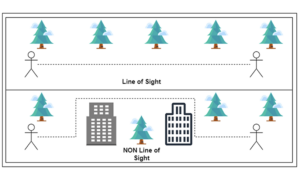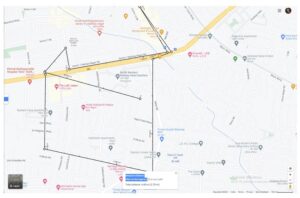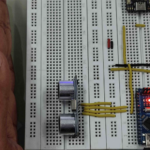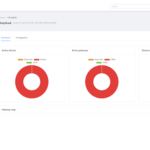In today’s world of communication, Long Range (LoRa) technology has taken a significant role, providing strong, long-distance connections. LoRa’s way of sending signals and its impressive reach make it an ideal option for many direct and indirect network paths.
This article explores how LoRa works in two situations: when devices can see each other (line-of-sight or LOS) and when they can’t (non-line-of-sight or NLOS). We’ll look at both node-to-node and node-to-gateway setups, discussing the benefits, challenges, and real-world uses.
In LOS, where devices are in an open setting, LoRa works well. It can cover large distances with little challenge, making it a good solution for monitoring systems. However, despite obstacles like buildings or trees (NLOS), LoRa can still work well, managing most reflections and disruptions. This makes it useful for cities and indoor setups.
In both scenarios, there are pros and cons. LOS provides a decent range and less interference, but a clear path is required. NLOS works even when things are in the way, but the range will likely be shorter. It all depends on what’s needed, whether tracking assets or controlling irrigation systems.
As technology advances, LoRa continues to be a reliable player in wireless communication.
LOS communication
In line-of-sight (LOS) communication, LoRa stands out. LOS refers to a direct, unobstructed path between the transmitting and receiving devices. LoRa’s use of chirp spread spectrum (CSS) modulation allows it to maintain reliable links over extended distances.
When there’s direct visibility, the signal faces little to no disturbances, enabling LoRa devices to achieve its maximum specified range. This makes LoRa an excellent option for tasks such as long-distance data collection, industrial monitoring, and precision agriculture.
Consider a real-life scenario where a farm employs LoRa devices to monitor the health of its cows. Each cow wears a healthcare device communicating essential information to the farmer’s residence. In this LOS setup, when there are no barriers, LoRa signals can cover a wide communication area as no barriers are blocking the signals. This application showcases the strength of LoRa in LOS conditions, ensuring seamless and efficient data exchange between remote locations and the farmer’s house.
Advantages of LOS communication
1. LoRa devices perform well when there’s a clear line of sight (LOS), showcasing peak range capabilities and seamless long-distance communication.
2. Paths without obstacles decrease signal problems, making LoRa more dependable.
3. LoRa network planning and setup become easier in clear-sight situations due to predictable signal spread. These qualities strengthen signal quality and data reliability and open doors for various uses. From IoT connections to remote monitoring, they change industries and connection options.
Challenges of LOS communication
Although direct communication (LOS) has advantages, it also deals with challenges from the land and structures. Obstacles like hills, buildings, and structures can impede direct transmission, limiting its range. Real-world limitations can also restrict its use, depending on the environment.
Such challenges highlight the requirement for flexible plans and new ideas, such as relay stations or smart adjustments, to reduce LOS limitations and guarantee steady connections. Adopting these improvements would expand LoRa’s usefulness in obstructive settings, making it useful in various applications like city planning, industry automation, and remote monitoring.
NLOS communication
Non-line of sight (NLOS) communication occurs when buildings, plants, and changes in the land block wireless signals. LoRa’s strength and energy-saving qualities stand out in NLOS situations.
For example, its way of sending signals can handle signal bouncing (multipath fading), ensuring a steady connection even when direct sight is blocked. LoRa’s ability to overcome these problems makes it a reliable option for many uses — including smart cities and environmental monitoring — where steady, long-distance communication is critical. It also improves the connection for the Internet-of-things (IoT) devices.
The above image shows a real-life example of communication without a direct line of sight (NLOS). In an urban city, electrical meter data from each residence is transmitted to the closest gateway. The challenge lies in high buildings obstructing direct paths between smaller houses and gateways.
However, with LoRa-powered sensors, electricity meters can overcome barriers. LoRa’s strength typically beats signal bouncing, essentially letting messages go around obstacles, making it a strong communication solution.
Advantages of NLOS communication
LoRa’s strength against signal bouncing and disruptions makes it a decent option for NLOS communication. Its adaptability enhances urban and indoor uses, while NLOS capability aids cost-efficient, flexible network planning — potentially cutting infrastructure costs in challenging areas.
Challenges of NLOS communication
LoRa does well in staying connected in NLOS situations, but the distance it can cover might not be as far as when there are no obstacles. Objects can weaken its signal and effectiveness. Despite a limited range, LoRa is still one of the best options for flexible and reliable communication in most environments.
LOS vs. NLOS
Choosing between LOS and NLOS communication depends on the specific application and the obstacles in the surroundings. For instance, in agricultural settings, where crops or terrain may obstruct the line of sight, NLOS LoRa communication can enable precision irrigation and monitoring. Conversely, LOS communication might be preferred for long-range asset tracking in rural areas with open landscapes.
A practical understanding
In the next LoRa article, we’ll explore uses of the LoRa E5 Mini-Board for testing distance and solving real problems. In LOS scenarios, the LoRa end node and gateway showcase an impressive range of about 3km. In NLOS conditions, this range slightly contracts to around 1.3km, highlighting LoRa’s adaptability.
The article explores node-to-node communication using the LoRa E5. In LOS, the range spans approximately 2km. In NLOS conditions, the range is roughly 800 meters.
These discoveries highlight how NLOS affects device-to-device communication in a detailed way.
Conclusion
LoRa communication works well in both line-of-sight and non-line-of-sight scenarios, offering decent range, resilience, and power efficiency. While LOS communication is better for longer distances and less disruption, NLOS communication can work reliably in cities and regions with obstacles.
Knowing how LoRa works in these environments can support smart planning decisions when setting up LoRa networks. As LoRa improves, its ability to work in different places makes it an essential part of wireless communication.
You may also like:
Filed Under: IoT applications, Tutorials













Questions related to this article?
👉Ask and discuss on Electro-Tech-Online.com and EDAboard.com forums.
Tell Us What You Think!!
You must be logged in to post a comment.